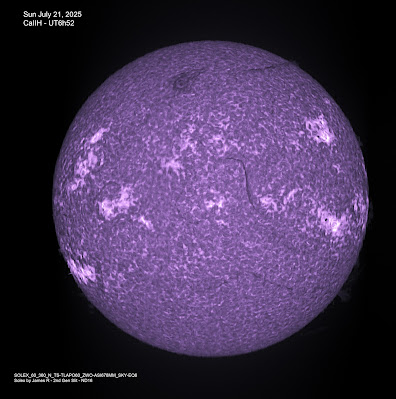Pascal Hilkens Astro Home Page
Saturday, July 26, 2025
An Atlas of Spectroheliograms from 3641 to 6600 Å by Varadi Nagy Pal
Tuesday, July 22, 2025
Monday, July 21, 2025
First Light of Sol'Ex by James R
I decided to go for the Sol'Ex design by James R as my previous two versions of my Sol'Ex (version 1 and pro version) are difficult to adjust concerning the collimator. I learned from Christian Buil that switching between H-alpha and CaIIH/K requires adjusting the collimator. I found this out but it was difficult to do this with version 1 and pro version of the Sol'Ex. The mechanism by James R is promising and looks easier to adjust the collimator.
My Helios colleague Johan L completed all the 3D print work which resulted in a very nice Sol'Ex: matt black, strong and robust design. The optics were bought from Shelyaq instruments which currently includes the 2nd Gen slit of 7micron width and 6mm height. The ZWO camera requires no extra tube as needed for the pro version.
First light: TLAPO60/360 with ND 16 filter was used with new Sol'Ex by James R. After fine tuning the focus of the mount and camera, I started to adjust the collimator. After some back and forth I was able the make my first scan using the H-alpha line. Inti was used to see the result and this was already very good. Next was the CaIIH line. Adjustment is very easy but finding the sweet spot is of course the challenge. Even though the seeing was moderate the Inti result of the CaIIH line was quit good.
SharpCap Log for H-alpha line:Output Format=SER file (*.ser)
Binning=1
Capture Area=3840x100
Colour Space=MONO16
Exposure/Gain Shift=0
Temperature=34,2
Hardware Binning=Off
High Speed Mode=On
Turbo USB=100
Flip=None
Frame Rate Limit=Maximum
Gain=144
Exposure=3,4720ms
SharpCap Log for CaII line:
Capture Area=3840x124Colour Space=MONO16
Exposure/Gain Shift=0
Temperature=34,3
Hardware Binning=Off
High Speed Mode=On
Turbo USB=100
Flip=None
Frame Rate Limit=Maximum
Gain=166
Exposure=5,4330ms
Sunday, July 20, 2025
E corona through Fe XIV - Description Setting
Imaging the E-Corona (Emission corona) through the Fe XIV line which millions time fainter then the photosphere.
JSolex 3.3.2 ImageMath E Corona Script
Improved setting by Olivier Aguerre# Reference (darkest line) of the scan (in Å)
refWl=5302.29
# Corona-E line (in Å)
targetWl=5302.90
# Continuum shift 1 (in Å)
c1=5301.5
# Continuum shift 2 (in Å)
c2=5303.6
# Fe XIV FWHM (in Å)
targetWl_fwhm=0.2
I made also 66 scans using my Sol'eX Pro 2nd Gen slit. JSolex 3.3.2 is used to stack the images. Editing was done using CS4, AstroSurface and DeNoise AI.
Saturday, July 19, 2025
E-Corona Fe XIV Rework using JSolex 3.3.2
Friday, July 18, 2025
Sun in FeI 5302,3A
Imaging the Sun in FeI 5303,3A with Solex Pro, 2nd Gen slit and ASI678MM.
Sunspots are visible aswell as some structure but I'm careful as setting is bin2x2 and scanspeed was 32x sidereal.
Thursday, July 17, 2025
E Corona FeXIV Third trial

















